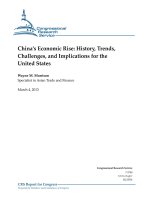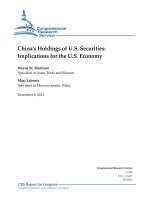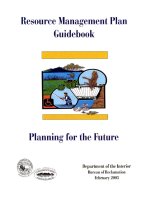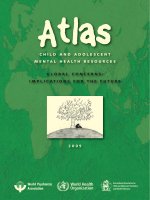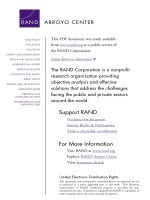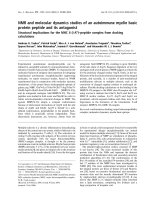Alternative Futures and Army Force Planning - Implications for the Future Force Era pdf
Bạn đang xem bản rút gọn của tài liệu. Xem và tải ngay bản đầy đủ của tài liệu tại đây (450.11 KB, 137 trang )
This PDF document was made available
from www.rand.org as a public service of
the RAND Corporation.
6
Jump down to document
Visit RAND at www.rand.org
Explore RAND Arroyo Center
View document details
This document and trademark(s) contained herein are protected by law
as indicated in a notice appearing later in this work. This electronic
representation of RAND intellectual property is provided for non-
commercial use only. Permission is required from RAND to reproduce, or
reuse in another form, any of our research documents.
Limited Electronic Distribution Rights
For More Information
CHILD POLICY
CIVIL JUSTICE
EDUCATION
ENERGY AND ENVIRONMENT
HEALTH AND HEALTH CARE
INTERNATIONAL AFFAIRS
NATIONAL SECURITY
POPULATION AND AGING
PUBLIC SAFETY
SCIENCE AND TECHNOLOGY
SUBSTANCE ABUSE
TERRORISM AND
HOMELAND SECURITY
TRANSPORTATION AND
INFRASTRUCTURE
The RAND Corporation is a nonprofit
research organization providing
objective analysis and effective
solutions that address the challenges
facing the public and private sectors
around the world.
Purchase this document
Browse Books & Publications
Make a charitable contribution
Support RAND
This product is part of the RAND Corporation monograph series.
RAND monographs present major research findings that address the
challenges facing the public and private sectors. All RAND mono-
graphs undergo rigorous peer review to ensure high standards for
research quality and objectivity.
Brian Nichiporuk
Prepared for the United States Army
Approved for public release, distribution unlimited
Alternative Futures
and Army Force
Planning
Implications for the
Future Force Era
The RAND Corporation is a nonprofit research organization providing
objective analysis and effective solutions that address the challenges
facing the public and private sectors around the world. RAND’s
publications do not necessarily reflect the opinions of its research clients
and sponsors.
R
®
is a registered trademark.
© Copyright 2005 RAND Corporation
All rights reserved. No part of this book may be reproduced in any
form by any electronic or mechanical means (including photocopying,
recording, or information storage and retrieval) without permission in
writing from RAND.
Published 2005 by the RAND Corporation
1776 Main Street, P.O. Box 2138, Santa Monica, CA 90407-2138
1200 South Hayes Street, Arlington, VA 22202-5050
201 North Craig Street, Suite 202, Pittsburgh, PA 15213-1516
RAND URL: />To order RAND documents or to obtain additional information, contact
Distribution Services: Telephone: (310) 451-7002;
Fax: (310) 451-6915; Email:
Library of Congress Cataloging-in-Publication Data
Nichiporuk, Brian, 1966-
Alternative futures and Army force planning : implications for the future force era /
Brian Nichiporuk.
p. cm.
“MG-219.”
Includes bibliographical references.
ISBN 0-8330-3744-7 (pbk.)
1. United States. Army—Reorganization. 2. Military planning—United States. 3.
United States. Army—
Personnel management. I.Title.
UA25.N5 2005
355.6'84'0973—dc22
20050013993
The research described in this report was sponsored by the United States
Army under Contract No. DASW01-01-C-0003.
iii
Preface
This monograph presents the results of a RAND Arroyo Center re-
search effort dedicated to creating six alternative future worlds for the
2025 timeframe and drawing out the implications of those worlds for
Army force size, structure, and design. The research was part of the
RAND Arroyo Center “Capstone Future Forces” project that was
conducted for the Deputy Chief of Staff for Operations and Plans
(DCSOPS).
The analysis contained in this report should be of interest to
those in the Army who are concerned with either intelligence fore-
casting or long-range force planning. Our alternative futures method-
ology is offered as a supplement to the “single point solution” ap-
proach to assessing the distant future that is often used within the
national security community. It is hoped that our alternative futures
tool can help the Army to devise effective hedging strategies that will
at least partially insulate the service against the vagaries of the often
rapidly changing international security environment.
All of the research for this monograph was conducted within
RAND Arroyo Center’s Strategy, Doctrine, and Resources Program.
RAND Arroyo Center, part of the RAND Corporation, is a federally
funded research and development center sponsored by the United
States Army.
iv Alternative Futures and Army Force Planning
For more information on RAND Arroyo Center, contact the Direc-
tor of Operations (telephone 310-393-0411, extension 6419; FAX
310-451-6952; email ), or visit Arroyo’s
web site at />v
Contents
Preface iii
Figures
ix
Summary
xi
Acknowledgments
xix
Abbreviations
xxi
CHAPTER ONE
Introduction 1
CHAPTER TWO
Project Methodology 5
Building Alternative Futures
5
Moving from Alternative Futures to Armies
10
CHAPTER THREE
Future Trends and the Creation of Alternative Futures 15
Geopolitics
15
Good Trends
16
Medium Trends
18
Bad Trends
20
Demographics
21
Good Trends
23
Medium Trends
24
Bad Trends
25
Economics
26
vi Alternative Futures and Army Force Planning
Good Trends 26
Medium Trends
27
Bad Trends
28
Technology
30
Good Trends
30
Medium Trends
31
Bad Trends
32
Environment
32
Good Trends
32
Medium Trends
34
Bad Trends
34
Next Step
35
CHAPTER FOUR
Describing the Alternative Futures 37
U.S. Unipolarity
37
Signposts
42
Scenario
43
Democratic Peace
45
Signposts
48
Scenario
48
Major Competitor Rising
51
Signposts
55
Scenario
56
Competitive Multipolarity
58
Signposts
61
Scenario
62
Transnational Web
64
Signposts
66
Scenario
67
Chaos/Anarchy
69
Signposts
71
Scenario
72
CHAPTER FIVE
Implications for Army Force Planning 75
Contents vii
U.S. Unipolarity and the “Light Lethal Army” 77
Moving from Capabilities to Characteristics
80
Democratic Peace and the “Policing Army”
82
Moving from Capabilities to Characteristics
85
Major Competitor Rising and the “Big War Army”
86
Moving from Capabilities to Characteristics
89
Competitive Multipolarity and the “Global Maneuver Army”
91
Moving from Capabilities to Characteristics
95
Transnational Web and the “Netwar Army”
97
Moving from Capabilities to Characteristics
100
Chaos/Anarchy and the “Dirty Environment Army”
101
Moving from Capabilities to Characteristics
104
CHAPTER SIX
Some Final Thoughts 105
References
109
ix
Figures
1. Project Methodology 6
2. The Full Matrix of Outcomes
7
3. A Continuum of the Six Futures
9
xi
Summary
Overview
Predicting the future is almost always fraught with uncertainty. How-
ever, Army force developers working to plan a force capable of meet-
ing the challenges of the 2025 timeframe (the Future Force era) face
more uncertainty than most. Today’s world, especially in the wake of
the September 11, 2001 terrorist attacks and the Iraq war, exhibits a
level of dynamism and change not seen during the comparatively
static decades of the Cold War—times when the drivers of U.S. secu-
rity policy were relatively fixed and their demands upon the Army
easily identified.
This study has attempted to help the Army deal with the task of
long-term force planning by using the tool of alternative futures
analysis. Rather than positing a single point estimate of the 2025 fu-
ture and trying to defend it, we chose to help the Army bound the
future by laying out a representative spectrum of different “future
worlds” in the hope that they would illustrate the complete universe
of future missions.
Project Methodology
The study’s methodology begins with the identification of five devel-
opment variables: geopolitics, economics, demographics, technology,
and the environment. These variables were drawn from drafts of The
Army Plan (TAP) that were circulated in late 1997. Conversion of
xii Alternative Futures and Army Force Planning
the development variables into alternative futures was accomplished
by varying the slopes of the trend lines of the five according to their
impact upon U.S. national interest. Good, medium, and bad slopes
were determined for each variable.
A good slope was defined as one that was beneficial to U.S. na-
tional interests. A medium slope was defined as one that was largely
neutral, while a bad slope was one that was damaging to the United
States and its interests. We then labeled the features of each trend line
with respect to the given development variable and produced a 53
matrix. The five development variables were arrayed vertically and the
three types of slopes arrayed horizontally. The cells of the matrix were
then filled with the labels for each individual trend line.
Through a process of mixing and matching cells, we produced a
set of six alternative futures: “U.S. Unipolarity” and “Democratic
Peace” (best cases), “Major Competitor” and “Competitive Multipo-
larity” (medium-good cases), “Transnational Web” (a medium-bad
case), and “Chaos/Anarchy” (worst case).
After the main features of each world were fleshed out, concrete
army types for each 2025 world were created. This entailed four
steps. Scenario selection was the first of these steps. Each scenario was
made as demanding as possible in the world at hand because it was
necessary to ensure that the army types we created would be capable
of handling all possible eventualities in each world. Secondly, there
was a need to set out the capabilities that the Army forces involved
would have to possess to carry out their mission in each scenario.
This was done by using the strategies-to-tasks methodology. Third,
force size and characteristics for each world were determined. Charac-
teristics were formulated as technical system types that meet the needs
presented in our capability statements. For each scenario, all the
needed characteristics were combined into a bundle that provides the
outline of an army type. Fourth and finally, common characteristics
seen across all or most of the six army types were identified.
Summary xiii
Describing the Alternative Futures
U.S. Unipolarity is a best-case future in which the United States re-
mains the world’s dominant power across the board, i.e., militarily,
economically, politically, and culturally. The other great powers
(China, Russia, the European Union, and India) are both unable and
unwilling to challenge the U.S led international order. In this world,
the security threats to the United States come from rogue regional
powers like Iran and Indonesia as well as from scattered ethnic con-
flicts and humanitarian disasters in the poorest parts of the develop-
ing world.
Democratic Peace is clearly an idealistic vision of the future.
Democratic Peace holds that liberal democracy and free, open mar-
kets have spread to such an extent that they are becoming institution-
alized in all of the world’s great powers (Europe, India, China, Japan,
Russia, Brazil) as well as most middle-ranking powers. Thus, in 2025,
liberal democracy is excluded only from some scattered pockets of
territory made up of the poorest developing nations. Large interstate
wars are not a realistic possibility in this kind of international system.
Spreading democracy has virtually eliminated the phenomenon of
“rogue regional states” in this vision of the 2025 future, so prolifera-
tion of weapons of mass destruction (WMD) is not a major security
issue for U.S. leaders in Democratic Peace. In specific terms, the key
zones of instability in the Democratic Peace world envisioned here for
2025 are northern Latin America, Sub-Saharan Africa, and parts of
South Asia.
Major Competitor Rising is the first of the two medium-good
worlds posited in this study. It portrays the emergence of a near-peer
competitor to the United States: a competitor with significant con-
ventional and strategic nuclear capabilities that include a power pro-
jection force and dedicated military space assets. Specifically, the
Major Competitor Rising world holds that a Sino-Russian Entente
forms in 2015–2018 with the goal of weakening America’s global po-
sition as well as that of its key allies.
Competitive Multipolarity is our second medium-good world.
In this future, we would see the emergence of two large powers that
xiv Alternative Futures and Army Force Planning
are capable of challenging the United States on roughly equal terms.
Each of these three powers would attempt to build its own coalition
of friends and allies at the expense of the other two. Here, instead of
witnessing large-scale warfare in a couple of key theaters, we would
see an ongoing competition between fluid defensive alliance systems,
with a mix of carrots and sticks being offered to critical small powers
in attempts to persuade them to either shift or maintain their present
political alignment. In Competitive Multipolarity, the United States,
Russia, and China each lead a major alliance system.
Transnational Web is the medium-bad world in our study and
represents a more unorthodox view of the 2025 future. It posits a
situation in which the nation-state has lost a substantial amount of
power to transnational actors, many of whom use the burgeoning In-
ternet to coordinate their actions worldwide much more rapidly than
can any national government bureaucracy. It is assumed here that a
substantial amount of nation-state power has been usurped upward
by transnational, globally distributed actors such as multinational
corporations, transnational criminal organizations (TCOs), and ter-
rorist networks. In this hypothetical future, the period from 2020 to
2025 witnesses a dramatic growth in the threat to the United States
posed by radical transnational “peace and social justice” groups. Al-
most all of these groups come to identify the United States as an
arch-villain that stands in the way of their drive to reshape the global
order.
The sixth and final world produced by this study was the worst-
case future—Chaos/Anarchy. Here, the nation-state has lost consid-
erable power to subnational actors. The premise of Chaos/Anarchy is
that factors such as overpopulation, environmental degradation, and
ethnic strife cause the collapse of the nation-state in large swaths of
the developing world. The resulting vacuum is filled by warlords
who, lacking a tax base, turn to terrorism and the smuggling of con-
traband, narcotics, and weapons of mass destruction to support their
“regimes.” This is a world of massive instability that frequently wit-
nesses mass migrations and virulent epidemics. The national security
threats posed to the United States here would often be very shadowy
and difficult to grapple with.
Summary xv
The Six Army Types
For each of the six worlds, a distinct Army type was created. It should
be noted that some common desired characteristics were observed
across all six Army types. These were: secure, reliable wireless com-
munications, robust and flexible logistics networks, and some form of
theater missile/air defense.
The U.S. Unipolarity world yielded a 2025 force that is called
the “Light Lethal Army.” The Light Lethal Army must have weight
and volume constraints sufficient to allow for all of its equipment and
initial sustainment to be moved over intercontinental distances in
C-17s and C-5s. This force would strike a good balance between mo-
bility and firepower. Its combat vehicles would have an all-terrain ca-
pability and would use speed rather than armor as a means of protec-
tion.
“Democratic Peace” yielded an army we call the “Policing
Army.” The Policing Army is designed mainly for participation in
multinational peacekeeping and cease-fire enforcement operations
within the overall context of a benign international system. This force
would be made up predominantly of high-quality light infantry, small
packets of 2000-vintage armor and armored infantry, significant
numbers of Special Forces detachments, and a robust force of reliable
transport helicopters.
A force called the “Big War Army” is this study’s response to the
Major Competitor world. The Big War Army would emphasize sur-
vivability over mobility in its maneuver forces, so its armored vehicles
would be heavier and slower than those seen in the Light Lethal
Army. The Big War Army would possess a large number of sophisti-
cated ground-based deep fires systems for the purpose of attriting en-
emy armor en masse, aiding the Air Force in the suppression of en-
emy air defense (SEAD) mission, and targeting adversary supply
routes and supply/logistics depots.
The “Global Maneuver Army” was constructed to meet the de-
mands of the Competitive Multipolarity future. This force is broadly
similar to the Light Lethal Army that was created to deal with our
first alternative future. The Global Maneuver Army will have signifi-
xvi Alternative Futures and Army Force Planning
cant self-deployable elements so that it can move into disputed re-
gions very quickly to achieve early forward presence. The characteris-
tics of the Global Maneuver Army that distinguish it from the Light
Lethal Army are its extensive and well-developed command and con-
trol (C2) and logistics networks.
Transnational Web’s challenges stimulated the creation of the
“Netwar Army.” The Netwar Army is designed to deal with net-
worked, geographically dispersed, hostile transnational actors. It has
three components: (1) an information warfare/cyberintelligence
group; (2) a cyber public affairs corps; and (3) a collection of special
operations forces–like teams designed for rapid movement overseas
and multiple, simultaneous strikes against terrorist cells located in
foreign countries. It is assumed that, in most cases, these SOF-type
units will work in tandem with foreign law enforcement agencies.
The study’s sixth and final army is called the “Dirty Environ-
ment Army.” The Dirty Environment Army is a response to the mass
disorder found in our worst-case world, Chaos/Anarchy. Essentially,
the Dirty Environment Army is a larger, more capable version of the
Policing Army that was discussed earlier. The Dirty Environment
Army has a very robust force-protection capability, including com-
prehensive defensive systems to protect personnel and equipment
against nuclear, chemical, and biological attack. In case these defenses
should fail, the Dirty Environment Army has a larger-than-usual
complement of medical personnel. This force’s combat capability is
oriented toward light infantry with light armor and heliborne sup-
port.
Some Final Thoughts
Although much of the research for this study was done during the
Army After Next (AAN) period that preceded the current Transfor-
mation initiative, the methodology presented herein for assessing the
future is still relevant to the Army because it is tied to general force
capabilities and characteristics and not to specific programs or plat-
forms. This research offers five areas of potential benefit to the Army:
Summary xvii
exposure to a spectrum of futures, a set of signposts for monitoring
the international security environment, some insights on the changes
in force structure size and intertheater mobility requirements across
the six worlds, a discussion of opportunities for hedging actions in
force planning, and, finally, a set of capabilities taken from across the
futures that can form the basis for a Full Spectrum Future Force
should the Army proceed with early deployment of the proposed fu-
ture combat system (FCS) family of platforms and technologies.
xix
Acknowledgments
The author would like to thank a number of individuals who con-
tributed to this monograph. Special appreciation goes to RAND col-
league Richard Darilek, who was the project leader of the “Capstone
Future Forces” study under which this research was conducted.
Richard’s unfailing patience and constant encouragement were the
key elements that moved this monograph forward to completion.
Colonel Frank Willingham, the Director of the G8 Force Develop-
ment Division of the Army Staff, was the project sponsor and was
exceptionally diligent in reviewing the later drafts of this publication.
David Kassing and Lauri Zeman of RAND both served as directors of
RAND Arroyo Center’s Strategy, Doctrine, and Resources Program
during the course of this research effort. Their long-term support for
this work was absolutely essential. RAND colleague David Shlapak
and LTC Robert Steinrauf of the Center for Army Analysis wrote in-
sightful peer reviews of an advanced draft of this report. Their com-
ments improved the final product greatly. RAND colleagues Bruce
Orvis, John Dumond, and Rick Eden provided excellent comments
on very early versions of the project briefing. Barbara Kenny and
Patrice Lester did superb work in converting this document into
proper RAND format, and Nikki Shacklett edited it with her cus-
tomary skill and thoroughness
.
xxi
Abbreviations
AAN Army After Next
AIDS Acquired Immune Deficiency Syndrome
APC Armored Personnel Carrier
APOD Aerial Point of Debarkation
ASAT Anti-Satellite
ASEAN Association of Southeast Asian Nations
ATBM Anti-Theater Ballistic Missile
AUC Autodefensas Unidas de Colombia
BDA Battle Damage Assessment
C2 Command and Control
C4ISR Command, Control, Communications,
Computers, Intelligence, Surveillance, and
Reconnaissance
CASTAB Cairo Stabilization
CDP Congo Democratic Party
CEP Circular Error Probable
CIA Central Intelligence Agency
COIN Counterinsurgency Operations
COLS Colombia Stabilization Force
xxii Alternative Futures and Army Force Planning
CONUS Continental United States
DCSOPS Deputy Chief of Staff for Operations and Plans
DNA Deoxyribonucleic Acid
DoD Department of Defense
EFA European Fighter Aircraft
EU European Union
FARC Colombian Revolutionary Armed Forces
FBI Federal Bureau of Investigation
FCS Future Combat System
FLIR Forward Looking Infrared Radar
GNP Gross National Product
GPS Global Positioning System
HUMINT Human Intelligence
IBM International Business Machines
ICBM Intercontinental Ballistic Missile
ICC International Criminal Court
IMF International Monetary Fund
IOC Initial Operating Capability
ISR Intelligence, Surveillance, and Reconnaissance
JSF Joint Strike Fighter
MEADS Medium Altitude Air Defense System
MOUT Military Operations on Urban Terrain
NATO North Atlantic Treaty Organization
NBC Nuclear, Biological, Chemical
NGO Nongovernmental Organization
NPT Nonproliferation Treaty
Abbreviations xxiii
NSC National Security Council
OAS Organization of American States
PGM Precision-Guided Munition
PLAAF The Chinese Air Force
POL Petroleum, Oil, Lubricant
PRC People’s Republic of China
RC Reserve Component
RMA Revolution in Military Affairs
SAM Surface-to-Air Missile
SASO Stability and Support Operations
SBCT Stryker Brigade Combat Team
SEAD Suppression of Enemy Air Defense
SIGINT Signal Intelligence
SOF Special Operations Forces
SOUTHCOM Southern Command
SPOD Seaport of Debarkation
TAP The Army Plan
TBM Theater Ballistic Missile
TCO Transnational Criminal Organizations
TDA Table of Distribution and Allowances
TEL Transporter-Erector-Launcher
THAAD Theater High-Altitude Area Defense
TMD Theater Missile Defense
TV Television
UAE United Arab Emirates
UAV Unmanned Aerial Vehicle

